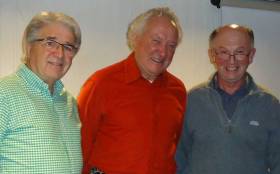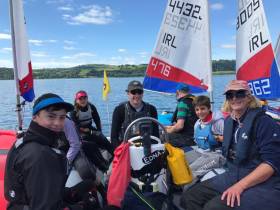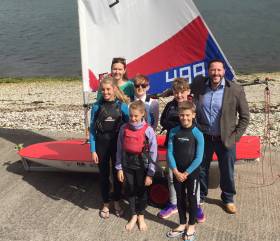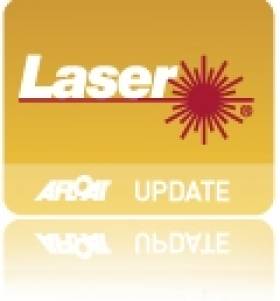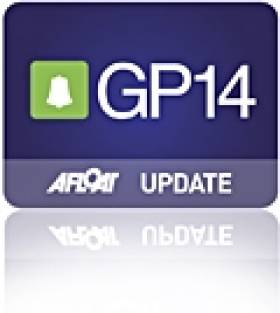Displaying items by tag: EAST ANTRIM BOAT CLUB
East Antrim Boat Club's 'Mid-Week Sessions' Close with a Bang
To say that East Antrim Boat Club's 'Mid-Week Sessions' closed with a bang would be something of an understatement writes Thomas Jobling. The hugely successful programme of talks, presentations and demonstrations at the Larne Lough club did indeed come to dramatic conclusion when EABC junior and Topper sailor, Zoe Whitford pulled the cord and deployed an RFD branded life-raft ... within the compact clubhouse! (The club's defibrillator was not required...)
Richard Kerrigan, Survitec Group's senior engineer at their Belfast manufacturing facility provided another packed house with an intriguing talk. It covered not only the history of the Belfast plant but the forward development of life-saving equipment: giant life-rafts capable of 'housing' hundreds of survivors to a new local RFD service facility and, a futuristic alternative to the traditional ship's lifeboat.
The entire Mid-Week Session programme has averaged an audience of 42 attendees over ten evenings. it has run every other Wednesday evening from November 2018 through to March this year.
Event organiser Tom Jobling speaking at the end of the final evening confirmed that MID-WEEK SESSIONS would return later in the year. That the opening night would be on Wednesday 4th September. "Same place, same time, same formula." Whilst hinting at what to expect, he was tight-lipped about who has already been signed up.
The club's Commodore Steven Kirby thanked Tom, as well as the membership who have fully supported the programme. He then offered a further thank you to the representatives from visiting clubs and finally to the Larne public who have also regularly dropped by.
If you would be interested in bringing a talk/presentation/demonstration to East Antrim BC during September, October and/or November 2019, please contact Tom either on mobile (07809691585) or by email; [email protected].
Hosted by East Antrim Boat Club as part of their hugely successful Mid-Week Sessions programme of illustrated talks, the ‘Prof’ Maurice O’Connell himself will be on stage from 7.30pm next Wednesday 6 March to present North Sails Ireland’s popular upwind trim seminar.
Event organiser Tom Jobling says: "When one hugely successful event meets another hugely successful event … get there early and not only for the posh seats, because this promises to be a big night — we’re expecting a full house at EABC."
Using North U Sail Trim simulation and supporting software, the Prof will be demonstrating the theory and practice of upwind sail trim and how to optimise your set-up for differing winds and sea states.
He will also be delivering techniques on how to escape from starts, and hints on how not to lose time on the race course.
At the previous Mid-Week Sessions night in mid February, Olympic 49er athlete Matt McGovern provided a captivated dinghy audience at the Larne Lough club with tips, for example, on how to explode from a crowded start, too. The Prof will be taking questions at the end of his already famed presentation.
“It’s going to be the event of the year,” said an enthused EABC Commodore Steven Kirby. “As with all the Mid-Week Sessions events this, too, will be no charge and open to non-members.”
For more information see the new EABC website and Facebook page, or call Tom Jobling on 07809 691585.
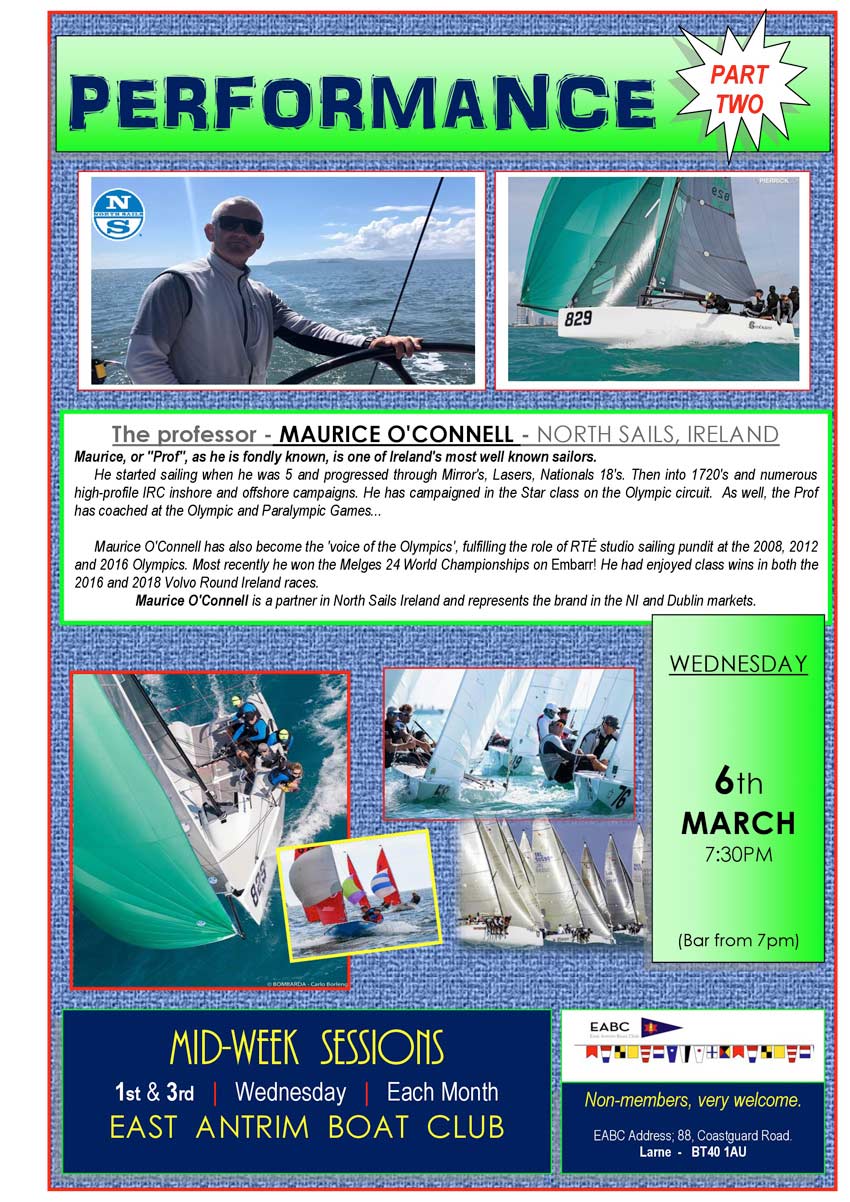
East Antrim Boat Club's inaugural run of its Mid-week Sessions programme of 'ashore' talks and presentations concluded on 28th November with the ITN broadcaster and high latitudes adventuring yachtsman Brian Black sharing his experiences of Arctic waters...
The 'Mid-week Sessions' were held on every Wednesday evening during November at the Larne Lough club. In due course over 100 members, as well as visitors from other Northern Ireland clubs, yachting and otherwise, made the journey - regardless of the foul weather at times - to enjoy EABC's innovative programme.
Robin Gray, the international race officer, got proceedings underway with his superb reveal on the happenings behind the scenes at the 2017/18 Volvo Ocean Race. Next up, and in contrast, it was the performance story-teller and writer, Jane Talbot. With her tales of wild-hearted wonder, of faeries, selkies & headless horsemen: she had her audience in the palm of her hand... On the 21st Nov., Dr David Hume MBE the eminent historian and broadcaster, took to the lectern to tell a packed clubhouse of the shipwrecks which litter the Antrim coast line.
A jubilant event organiser, the nautical novelist Tom Jobling said. "In many ways it was a risky project, but by bringing to our members, their guests and visiting non-members such a variety of speakers, we seem to have, as they say, 'squared the circle'. Robin Gray for example, really set the bar high with his illustrations and anecdotes, but Jane, cleared it! David's night caught us out - we ran out of chairs... As for Brian Black, well, we received a presentation of a standard expected of a professional broadcaster. It was, at times a 'nail-biter' while his slides touched the audience with the sheer beauty of the region. However, and as a climate campaigner and film maker he also showed us the ugly side - the pollution, and indeed the scary effects of changing climate... "
As something of a bonus, Brian had also waived his fee in favour of a collection towards a little known charity; www.sea-changers.org.uk. Club commodore Steven Kirby announced later that the collection which was topped off by EABC, raised £170.
The MID-WEEK SESSIONS return on 9th January 2019 with the maritime historian Guy Warner and his illustrated talk on the front-line role that Larne Harbour played in defeating the W.W.1 U-boat menace of the North Channel and Irish Sea.
Hosted by East Antrim Boat Club over three days in July - 7th to 9th - the Blazin Digital sponsored Topper Class Irish National Championship was sailed on Larne Lough in testing conditions writes Tom Jobling.
Headed up by local R. O. Richard Doig the race committee got the full programme away despite having to overcome lengthy periods of dead calm, and several course 'realignments'.
In the 53 strong 'full-rig' Topper fleet it was British Team member Lorcan Knowles from Leigh & Lawton SC, a hot-bed of Topper competition, who emerged as the clear victor. Maidenhead's Leo Wilkinson was the runner-up with Aoife Byrne of Royal Cork YC third overall. In the 4.2 fleet, the local girl Zoe Whitford was squeezed into second place overall by Christian Houlihan of Blessington SC. Carrickfergus Sailing Club's Mathew McClernon was third.
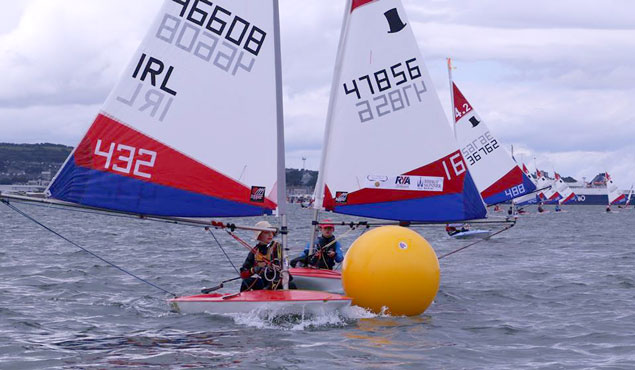 Toppers close at a gybe mark at Larne
Toppers close at a gybe mark at Larne
In total 63 competitors entered the event - now in its 30th year - and the following sailors won special category awards: first under 17 sailor was Conor Horgan RCYC.
Best under 14 sailor went to British Team member, George Vincent of Parkstone SC and the under 12 award was collected by Co. Antrim YC sailor Daniel Corbett.
Summing up the championship ITCA's Simon McIllwaine said; "Already established as one of the premier Topper venues with their Winter Series, East Antrim Boat Club lived up to and exceeded all expectations at this year's Irish National Championships. The management of the racecourse under very challenging and shifting wind conditions was executed seamlessly and although at times," he continued, "the competitors found the wind just a little frustrating, there was a great spirit between all of the sailors and their parents both on and off the water. Thank you to the club for all their hard work and for making everyone feel so welcome during those three days on and around Larne Lough. A very memorable 30th anniversary of the championship."
With only days to go, the countdown towards the Topper Irish National Championships - now in its 30th year - has started in earnest.
East Antrim Boat Club are the hosts and the leading LED signage and marketing company Blazin Digital are the sponsors for this all-Ireland youth extravaganza.
The championship, which will be sailed on the expanses of Larne Lough, runs from 7th to 9th July. It has already attracted huge interest with over 50 online entries already confirmed. Competitors will be travelling from across the provinces of Ireland, as well as from various GB based Topper fleets.
At the launch of this Topper championship East Antrim's Commodore Stephen Craig said; "We are honoured to be awarded this prestigious event and delighted to be alongside the Topper family again. We of course welcome aboard our principal, and very generous sponsor, Blazin Digital." He continued, "EABC's Topper fleet will be led out by Rory Williamson, our newest champion sailor.
Rory brought home the Topper Southern title recently. Finally, and on behalf of the membership here at EABC, I send a welcome to the competitors their families and supporters. Let me also take this opportunity to thank all of our club volunteers, and indeed the support of our neighbouring clubs, without whom this event would not be possible."
The final words are from the thirteen-year-old Topper Southern Champion, EABC's Rory Williamson; "I am really excited that the Irish Nationals are being held at East Antrim Boat Club. To get a good result at my own club would be fantastic so I will be trying my hardest to place well. I am looking forward to not only racing with my fellow Irish sailors but also some of my friends from England, Scotland and Wales. I think it is going to be an amazing few days of racing. BRING IT ON!"
Larne RNLI Launches New Lifeboat
Volunteers, supporters and friends of Larne RNLI gathered this weekend at the East Antrim Boat Club to attend the official Naming Ceremony and Service of Dedication for the lifeboat station’s new D-class lifeboat Terry. The new inshore lifeboat was provided through the Pistol Benefit Fund, which was set up in memory of Frederick (Fred) and Theresa (Terry) Pistol and named Terry in memory of Fred’s beloved wife Theresa.
The Pistol Benefit Fund has its origins in Frederick Pistol’s incredible life. Fred came to the UK from Austria, as a 19-year old refugee fleeing the Holocaust. He arrived with nothing more than the clothes on his back and worked as a fitter until the Second World War started. He joined the army, eventually becoming a Major and returned to England in 1946 after serving abroad. He married Theresa (Terry) a concert pianist born in Westcliff-on-Sea and discovered a passion for sailing, one that has been passed down through the family. Every boat Fred bought was named Terry after his wife and Larne RNLI’s new D-class lifeboat now proudly bears the name.
Attending the ceremony were members of the Pistol family, who have supported the work of the RNLI for many years. Fred and Theresa’s son Neil and his wife Viveca were special guests along with their two sons, Ben and Josh and their friend Simon Perlmutter. Their daughter Gabriella was unable to attend as she is currently travelling but she was being kept up to date with the proceedings by her brothers. Close friends of the couple, Alan and Shirley Shalet, also made the journey on what would have been Fred’s birthday.
Allan Dorman, Larne RNLI Lifeboat Operations Manager, who accepted the lifeboat into the care of the station said; ‘Every naming ceremony for a new lifeboat is a special occasion and this is no exception, as we honour the Pistol family and their generous life-saving gift to the Institution and the people of Larne. We will remember Frederick and Theresa through the work of this lifeboat and the volunteer crew and we will be the proud custodians of it for many years to come.’
Speaking during the ceremony Neil Pistol said, ‘Thank you for honouring my family and allowing me this privilege. Thank you to the RNLI for being there. Thank you for going out into conditions when others are safe in harbour. Thank you for risking your lives to save others. You, all the members of the RNLI, make a difference. You do not discriminate; you solely take action to save others.
Neil also expressed his pleasure on learning, during an earlier tour of the lifeboat station, that the name of the RNLI rescue mannequin, lifeboat crew use during training, is named Fred. He concluded his speech by acknowledging this, to the delight of the crowd;
‘It will bring us all great pleasure to know that in real life as in previous real-life, Terry will continue to rescue Fred, during the station’s regular training sessions. In the end we make our own destiny. Good luck and Godspeed to all the Larne crew. It gives me great pleasure to hand this lifeboat into the care of the RNLI.’
The D-class lifeboat remains the workhorse of the RNLI as it has for nearly 50 years. Built at a cost of £48,000, the inflatable craft is highly manoeuvrable and specifically suited to surf, shallow water and confined locations – often working close to cliffs, among rocks or even in caves. Importantly it can also be righted manually by the crew in the event of capsize.
It is the smallest class in the RNLI lifeboat fleet but its impact on search and rescue has been huge. The D class carries out some of the most difficult and dangerous rescues lifeboat crews have faced.
The platform party at the service were Mr. Tommy Hutcheson, retired Deputy Launching Authority for Larne RNLI who welcomed guests and opened proceedings; Mr Neil Pistol, who presented the RNLI with the new lifeboat, Christopher Brooke, RNLI Irish Council member who accepted the lifeboat on behalf of the RNLI and handed her into the care of the station; Mr. Allan Dorman, Larne RNLI Lifeboat Operations Manager, who accepted the lifeboat on behalf of the station; Darren Byers RNLI Divisional Operations Manager for Northern Ireland and the Isle of Man who spoke on the capabilities of the new lifeboat and Ms Karen Black, one of the founding crew members of Larne RNLI who recently retired and who officially named the lifeboat.
The Very Reverend Aidan Kerr, the Venerable Stephen Forde, Reverend Tommy Stevenson and Reverend Doctor Colin McClure lead the Service of Dedication with specially chosen hymns and readings. Music was provided by
Magheramourne Silver Band.
Last year Larne RNLI celebrated 20 years of lifesaving during which time the volunteer lifeboat crew launched 411 times, saving 31 lives and rescuing 326 people. Larne RNLI operates both a D-class inshore lifeboat and a Trent class all-weather lifeboat.
#lasersailing – Four race wins from six sailed at the Ulster Laser Championships at East Antrim Boat Club gave 2016 Olympic contender Finn Lynch of the National Yacht Club a clean sweep of the 15–boat standard fleet. It's the 17–year–old's second regional title this season he picked up Munster honours at Baltimore a month ago.
In the 15–boat radial division, youth national champion Seafra Guilfoyle of Royal Cork went one better to seal the title with five race wins.
In the 4.7s, there was a similar domination as Guilfoyle's club mate Johnny Durcan took four wins. His twin brother, Harry, was also in winning form at the weekend at the Optimist Connaughts.
Full results are available to download below.
Business as Usual for Corcoran and Brogan in GP Hot Toddy Event
Started in 1982 the season ending Hot Toddy event returned to it's originating Club in Larne on 22/23 October. Twenty two boats took to the water on a damp and overcast day with a Force 3-4 Easterly blowing over the hilly east coast of the lough, constantly varying in strength and direction and providing challenging racing conditions.
It seemed like business as usual for Tim Corcoran and Brendan Brogan, despite having sailed very little since the Irish Champs, as they reeled off three firsts in a row, starting and sailing very consistently. The first race was even more "business as usual" as John and Donal McGuinness took second place with President Richard Street and Dan Crilly third. Things were soon to change when silver fleet sailor (for how much longer?) Nigel Sloan and Michael Cox took second place holding off Norman and Rob Lee, While in the third race Curly Morris sailing with daughter Mel (bit of a comedown after sailing with Ger Owens in the last two events) took second with the rapidly improving Keith Louden and Dessie Hughes third.
Sunday was bright and clear although cool and as the wind backed slowly into a more northerly direction it became a little steadier in strength and direction. In the lightest conditions of the weekend (Force 3) Curly and Mel had another good pin end start but this time held on to lead at the first mark and throughout the race despite a strong challenge from Keith and Dessie who held off Tim and Brendan comfortably.
With the breeze strengthened to Force 3-4, Keith made a perfect pin end start and took a lead they were not to loose, despite strong challenges from both Norman and Rob and Nigel and Michael, the latter pair ultimately taking their second second place of the weekend. This was Keith and Dessie's first race win at a major event and well deserved. As both Keith and Richard have ben trying to "break their duck" by winning a race for a number of years, this was the inspiration Richard and Dan needed to do the same in the final race. With John and Donal in second place and well clear of the rest of the fleet their victory was hard earned with a lot of cover tacking! The Presidential celebrations could be heard all the way down to the leeward mark.
With a third and fifth in the first two races Tim and Brendan didn't need to sail the final race but for the next four boats the minor places were up for grabs. Race officer Richard Doig had reverted to an Olympic style course and with the wind backing steadily to the North the final reach became a bit of a cavalry charge with much tactical sailing. Robert and Ross Gingles managed to hold on to the inside berth at the final mark on Curly and Mel who in turn kept out Keith and Dessie and Alistair Duffin and Paul Whitcombe the latter having a quiet weekend by their standards. Despite slipping to 7th on the last beat this was enough to shade out Norman and Rob on tie break.
In the silver fleet Nigel and Michael's two second place finishes gave them a comfortable lead over Cathal Sheridan and David Lappin, with Steven Preston and Brenda Niblock doing enough to beat clubmates Lawrence Balham and T Brown
Lough Foyle Y.C. could be proud of their weekend as in addition to Keith and Dessie in second and Ken Louden and Ryan Louden also making the top ten. The bronze fleet was a L.F.Y.C. clean sweep! Kevin and J Lynch took the honours from Bill Johnston and James Hockley and Daniel and Gareth Gallagher in third place, with only eight points between the three of them. We look forward to seeing more of these up and coming sailors next year and not just when we go to Lough Foyle for one of our events.
The event marked 50 years of sailing at E.A.B.C. much of it dominated by a very strong GP14 fleet. Curly Morris was not the only sailor participating in the event to have launched their first GP14 fifty years ago – Commodore Paddy Thompson persuaded former N.I. champion Michael Hill to get his series 1 boat Trostan out of the garage and onto the water and revive a host of memories.






























